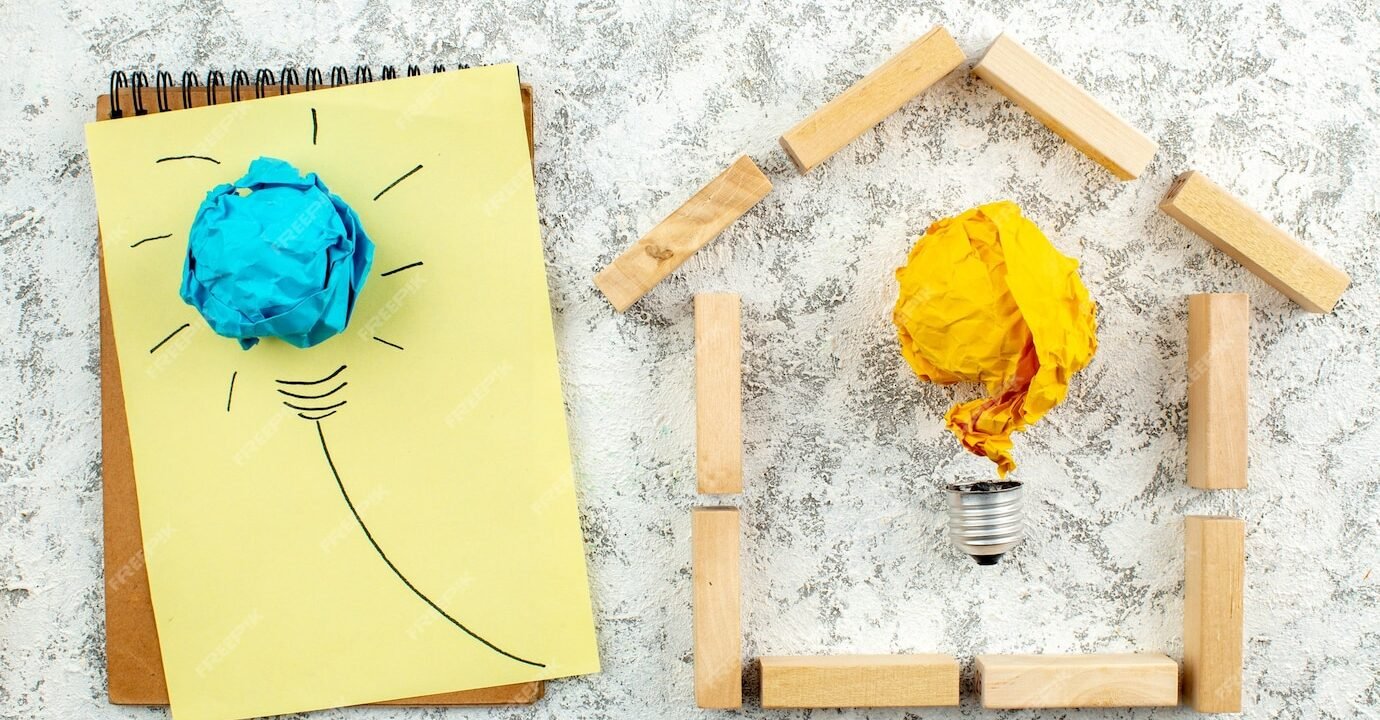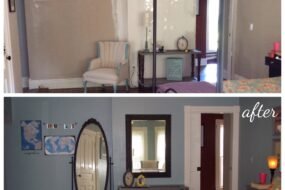
There’s something incredibly satisfying about transforming a space or item with your own two hands. DIY projects allow you to bring your vision to life, whether it’s a cozy nook for relaxation, a stylish accent wall, or a one-of-a-kind piece of furniture. The best part? DIYs are a perfect way to flex your creativity and personalize your home, all while saving money.
If you’ve ever been in a creative rut or unsure where to start with your next project, look no further. In this post, we’ll explore 10 inspiring DIY ideas that can spark your next home improvement venture. From unique decor ideas to creative upcycling projects, these ideas will help you add personality and charm to your home.
1. Create a Gallery Wall for Personal Touches
A gallery wall is one of the easiest and most impactful ways to decorate a blank wall. It allows you to showcase your favorite artwork, family photos, quotes, or prints in a curated arrangement that adds personality and style to your space. You don’t need to be a professional designer to create a gallery wall—just a few thoughtful pieces and some creativity will make it your own.
Materials you’ll need:
- Picture frames (various sizes)
- Artwork, photos, or prints
- Picture hanging tools (nails, hooks, or adhesive strips)
- Level for even spacing
How-to:
- Gather your artwork: Select a few pieces of art, photos, or prints that resonate with your personal style or reflect the theme of the room.
- Frame them: Choose frames that complement the art. You can opt for matching frames for a cohesive look or mix and match for a more eclectic style.
- Arrange your layout: Before hanging, lay out your frames on the floor to test different arrangements. Consider whether you want a symmetrical grid or a more freeform, organic layout.
- Hang the artwork: Once you’ve found your arrangement, begin hanging your frames on the wall, starting with the central piece and working outward. Use a level to ensure even spacing and alignment.
A gallery wall adds a focal point to any room and is a fantastic way to reflect your personal style while displaying cherished memories or inspiring artwork.
2. DIY Statement Lighting for a Unique Touch
Lighting is essential in creating the right atmosphere in any room, and adding a custom DIY lighting fixture can instantly elevate the space. Whether it’s a pendant light made from repurposed materials or a chic chandelier, a unique lighting fixture can become the centerpiece of the room.
Materials you’ll need:
- Light fixture kit (can be purchased from hardware stores or online)
- Pendant or chandelier components (like ropes, pipes, or branches)
- Light bulbs
- Drill
- Ceiling hooks (if necessary)
How-to:
- Choose your lighting style: Decide on the style of lighting you want to create. For a modern look, try making a geometric pendant light out of copper piping, or for a boho feel, hang string lights in mason jars.
- Prepare your materials: Gather all the materials for your fixture. If you’re using a chandelier base, clean it up and paint or stain it to match your room’s color scheme.
- Assemble the fixture: Follow the instructions included with your light fixture kit to assemble the fixture. If you’re creating a custom design, such as hanging lights from a branch, drill holes for your light sockets and hang them securely.
- Install the fixture: Attach the new light fixture to your ceiling, ensuring that all wires are properly connected and that the fixture is securely fastened. Always turn off the electricity before starting this project for safety.
A custom light fixture will not only illuminate the space but also add an instant wow factor to any room.
3. Upcycled Furniture: Give Old Pieces a New Life
Upcycling is a great way to breathe new life into old furniture and reduce waste at the same time. Whether it’s an outdated dresser, a worn-out coffee table, or a tired bookshelf, upcycling can transform these items into beautiful and functional pieces that perfectly match your style.
Materials you’ll need:
- Old furniture piece (e.g., dresser, bookshelf, coffee table)
- Sandpaper
- Paint or stain
- Paintbrushes or rollers
- New hardware (optional)
- Wood filler (optional)
How-to:
- Prepare the furniture: Begin by sanding down the old furniture to remove any paint, varnish, or rough spots. Use wood filler to patch up any holes or imperfections.
- Paint or stain: Choose a color or finish that will complement your room’s decor. For a fresh, modern look, you might opt for matte or chalk paint; for a more classic finish, a rich wood stain might be ideal.
- Add new hardware: Swap out old handles or knobs with stylish, new ones to give your furniture an updated look.
- Seal and protect: Once the paint or stain has dried, apply a clear coat of sealer to protect the finish and ensure the longevity of your upcycled piece.
Upcycling is a fun and rewarding DIY project that not only saves you money but also helps to keep furniture out of landfills while creating custom pieces that reflect your style.
4. Macramé Wall Hangings for Boho Vibes
Macramé is a versatile crafting technique that uses knotting to create beautiful and textured designs. Macramé wall hangings are perfect for adding a touch of boho charm to any room. They can range from simple, minimalist pieces to elaborate, intricate designs, making them a fantastic DIY project for all skill levels.
Materials you’ll need:
- Macramé cord (available at craft stores)
- Wooden dowel or branch
- Scissors
- Beads or decorative accents (optional)
How-to:
- Cut the cord: Cut your macramé cord into equal lengths, depending on the size of the wall hanging you wish to create.
- Create the knots: Begin knotting the cord using basic macramé knots like the square knot or the lark’s head knot. You can follow tutorials online for different knotting techniques or create a design of your own.
- Add decorative elements: If desired, add beads or other decorative elements to your macramé design to give it a unique touch.
- Hang the piece: Once you’ve finished knotting, trim any excess cord and hang your macramé piece from a wooden dowel or branch on the wall.
Macramé wall hangings add texture and visual interest to your space while offering a handmade, artistic touch. It’s a fun and rewarding project that can easily be customized to fit your aesthetic.
5. Indoor Herb Garden for Freshness and Flavor
Having fresh herbs readily available in your kitchen can elevate your cooking game. Plus, an indoor herb garden can serve as a beautiful and functional addition to your home. Whether you have a large kitchen or just a small windowsill, growing herbs at home is a simple and rewarding DIY project.
Materials you’ll need:
- Small pots or containers
- Potting soil
- Herb seeds or starter plants (e.g., basil, thyme, rosemary, mint)
- A tray to catch excess water (optional)
- Watering can or spray bottle
How-to:
- Choose your herbs: Select herbs that you use frequently in your cooking. Some popular indoor herbs include basil, parsley, mint, and chives.
- Prepare your containers: Fill each pot with potting soil, leaving about an inch of space from the top.
- Plant your herbs: Sow your herb seeds according to the directions on the seed packets or plant your starter plants into the pots.
- Place the pots: Set your herb pots on a windowsill or another sunny spot where they will receive plenty of light.
- Care for your herbs: Water your plants regularly and trim them as needed to encourage growth.
An indoor herb garden not only adds greenery to your space but also provides fresh herbs for cooking, making it a practical and beautiful DIY project.
6. Customized Planters for a Personal Touch
Planting is a great way to add life to your home, but why settle for generic planters when you can create your own custom designs? From painted pots to repurposed containers, DIY planters allow you to infuse your space with your own style while also showcasing your green thumb.
Materials you’ll need:
- Plain flower pots or containers (old mason jars, cans, etc.)
- Paint (acrylic or spray paint)
- Decorative elements (ribbons, fabric, beads)
- Plants or flowers
How-to:
- Prepare the pots: Clean your pots or containers thoroughly to remove any dirt or old labels.
- Paint and decorate: Paint your pots with fun colors or patterns, or add fabric or decorative paper for a unique touch. Let the paint dry completely before adding plants.
- Plant your greenery: Add soil to the bottom of your pot and place your plants or flowers inside. Add more soil around the plant, and water it as needed.
- Display: Arrange your newly customized planters on shelves, windowsills, or as table centerpieces.
Customized planters are a quick and easy DIY project that can add color and personality to your home while providing a home for your favorite plants.
7. Repurposed Wooden Pallet Furniture
Wooden pallets are a versatile material that can be repurposed into a variety of furniture pieces, from coffee tables to bed frames. With a little creativity and elbow grease, you can turn these simple pallets into stunning pieces that complement your home.
Materials you’ll need:
- Wooden pallets
- Sandpaper
- Paint or stain
- Screws
- Drill
- Saw (optional)
How-to:
- Select your pallets: Find sturdy wooden pallets at your local hardware store, or upcycle old ones you may have lying around.
- Sand the wood: Sand down the surface of the pallets to remove rough edges and splinters.
- Assemble your piece: Depending on what you want to create, stack the pallets and secure them together using screws. For a coffee table, you can stack two pallets and add wheels for mobility.
- Paint or stain: Finish the wood with your choice of paint or stain to match your home’s decor.
- Add finishing touches: Complete the furniture piece with additional details like cushions, glass tops (for tables), or decorative legs.
Repurposed pallet furniture adds a rustic, industrial charm to your home, and it’s a great way to get creative while being eco-friendly.
8. DIY Accent Walls to Transform Any Room
An accent wall is a simple yet striking way to create a focal point in a room. Whether you opt for bold paint, wallpaper, or reclaimed wood, an accent wall can transform a space in no time.
Materials you’ll need:
- Paint or wallpaper
- Painter’s tape (for clean lines)
- Brushes or wallpaper paste
- Wall panels or reclaimed wood (optional)
How-to:
- Choose your wall: Pick a wall that you want to highlight, typically the one that is most visible in the room.
- Prepare the surface: Clean and prep the wall by removing any dirt or debris.
- Apply the paint or wallpaper: If painting, tape off the edges for clean lines and apply the paint. For wallpaper, carefully measure and cut the wallpaper, then apply it with wallpaper paste.
- Install panels or wood: If using reclaimed wood or panels, measure the space and securely attach them to the wall.
An accent wall adds depth and visual interest to any room, and the materials you choose can reflect your personal style.
9. DIY Window Treatments for Privacy and Style
Custom window treatments are an easy and affordable way to add style to a room while also enhancing privacy and light control. Whether you opt for custom curtains, Roman shades, or a stylish curtain rod, window treatments can completely change the mood of a room.
Materials you’ll need:
- Fabric (for curtains or shades)
- Curtain rod or wire (optional)
- Sewing machine or fabric glue
- Curtain rings or hooks
How-to:
- Measure your windows: Measure the dimensions of your window to determine the size of fabric you need.
- Cut and sew: If you’re making curtains, cut the fabric to size and sew the edges for a clean finish. You can also use fabric glue for a no-sew option.
- Install the curtain rod: Secure the curtain rod or wire above the window and attach your curtains or shades using rings or hooks.
- Adjust as needed: Ensure the curtains hang properly and adjust the length if necessary.
DIY window treatments provide both functionality and beauty to your home, giving you complete control over the look and feel of your space.
10. Personalized Throw Pillows for Extra Comfort
A few well-placed throw pillows can make any couch or bed feel more inviting. By creating your own personalized pillows, you can easily enhance the comfort and aesthetic of any room.
Materials you’ll need:
- Fabric (for pillow covers)
- Pillow inserts or old pillows
- Sewing machine or fabric glue
- Decorative accents (buttons, tassels, or embroidery)
How-to:
- Cut the fabric: Measure and cut two pieces of fabric to create a pillow cover. Allow extra fabric for seams.
- Sew or glue: If sewing, stitch the edges together, leaving one side open. Alternatively, use fabric glue to attach the edges.
- Add decorative accents: Embellish the pillows with buttons, embroidery, or tassels to give them a personal touch.
- Insert the pillow: Place your pillow insert into the cover and sew or glue the opening shut.
Personalized throw pillows are a simple way to inject a bit of personality and comfort into your home decor, and they make great gifts too!
Conclusion
There’s no limit to the creativity and personal touches you can add to your home with DIY projects. Whether you’re upcycling furniture, designing a custom lighting fixture, or creating a beautiful gallery wall, these ideas will inspire you to start crafting your own dream space. Get your hands dirty, let your imagination soar, and enjoy the process of transforming your home into a unique reflection of your personality!








